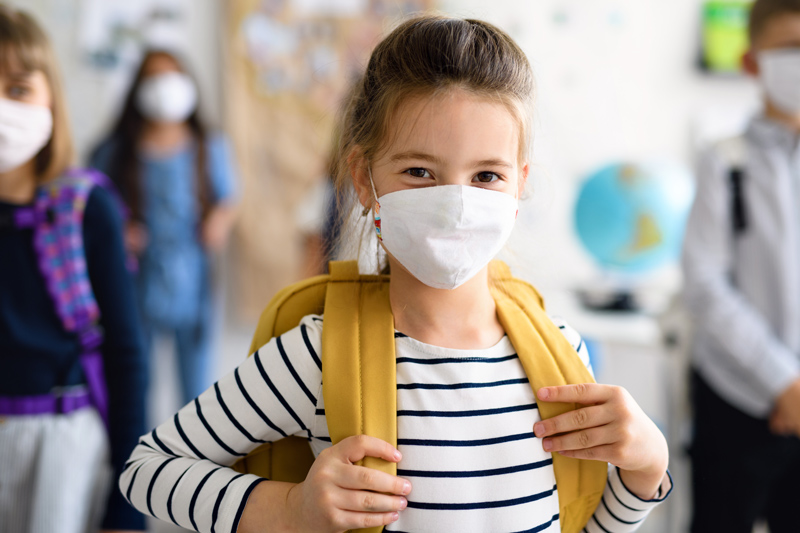Transitions are tough. As many schools make plans to shift from distance learning to in-person instruction, families, students, and educators face an adjustment period. That’s especially true for students with autism spectrum disorder, because transitions can be particularly stressful and challenging for them.

“The pandemic has been disruptive for children across the board,” said Patricia Schetter, a board-certified behavior analyst who coordinates the Autism Education Initiatives for the Center for Excellence in Developmental Disabilities at the UC Davis MIND Institute. “Especially for children with autism and their families, so many aspects of their education have been affected, including access to therapies as well as educational and social interactions.”
Schetter noted that the pandemic forced everyone to learn new routines and new ways of working, learning, and recreating. “Now, there will be a new period of learning, because in-person school won’t look like it did a year ago. There will be masks, distancing, and hybrid schedules to get used to,” she explained.
Since the pandemic began, Schetter’s work has focused largely on supporting families and educators with the adjustment to online learning. Now, parents and teachers are asking for resources and supports to help children with autism return to the classroom. Click here for a handy guide.
She offers some tips that her team has collected:
- Help them get comfortable again with the building and school grounds before in-person instruction begins. Visit on a weekend day and walk around if possible, helping the student to reacclimate. Another way to do this is to use a social story like this one from Autism Little Learners, which illustrates the changes students may experience, like the teacher wearing a mask or desks being farther apart.
- Practice wearing a mask. Many kids will not be used to wearing a mask for hours, and it may be unfamiliar and uncomfortable. Have the student wear one at home for short periods and gradually increase it to get them used to keeping it on for a significant time. Click here to see a social story about wearing masks from the MIND Institute. Or try this handy guide for helping kids get comfortable with masks.
- Begin reinstating some of the nighttime routines and morning routines that will need to be in place when school starts. Use visual supports, like photos or checklists, if needed, so children know what the steps of the routine are.
- Establishing a new school routine is also really important. Setting a schedule and daily expectations is key to helping kids feel safe and secure at school. “Students must be comfortable in order to re-engage and connect, and that will enable them to be ready to learn, noted Schetter. “That will also help teachers recognize their strengths and interests and increase motivation.”
- Be patient. There will be a period of acclimation, and educators and therapists will first need to make sure the student is stabilized. “It will be really important not to push too hard, too fast as it might overwhelm and discourage many students as they readjust to being at school,” said Schetter.
- Reconnecting with kids and helping them to feel safe and secure at school will be key, and the best way to do that is to establish clear expectations, schedules and routines and to focus on children’s strengths and interests. This will help kids be available to learn, and when their strengths are recognized and their interests are incorporated into learning, they will be more motivated to engage.
- Keep your expectations reasonable. “Some kids may require more intensive or individualized instruction to regain skills,” she said. Educators and families should work together to develop an individualized plan that will meet the needs of the child.
- Be open to nontraditional methods for addressing learning loss. “Things like summer school, before or after school interventions, small groups of individualized instruction may all be on the table, so parents should work really closely with their educational teams to determine what the best fit is for their child,” noted Schetter.
- Stick to what works. The use of evidence-based practices by teachers and therapists is the best way to help kids regain lost skills and acquire new ones. “Things like visual supports, positive behavior supports, and social skills teaching have all been proven to be highly effective,” she said. These Autism Focused Intervention Resources and Modules provide training for educators and parents.
- Remember that what works for your child may not work for others. Schetter noted that many kids are benefiting from online learning and may experience less social anxiety at home, while many students with autism benefit more from face-to-face instruction and live social interactions.
Schetter’s team at the California Autism professional training and information network (CAPTAIN) put together an excellent list of resources for educators and families.
“Families have had to adopt many roles during the pandemic: surrogate teacher, therapist and primary social partners for their kids,” explained Schetter. “As we transition back to in-person instruction, I expect everyone will benefit from the increased understanding and collaboration that distance learning necessitated.”
At the UC Davis MIND Institute, world-renowned scientists engage in collaborative, interdisciplinary research to find the causes of and develop treatments for the disabilities that can be associated with autism, attention-deficit/hyperactivity disorder (ADHD), fragile X syndrome, 22q11.2 deletion syndrome, Down syndrome, and other neurodevelopmental disorders. For more information, visit mindinstitute.ucdavis.edu.
This article has been republished with permission from UC Davis Health. You may view the original article, published on March 9, 2022, at https://health.ucdavis.edu/news/headlines/helping-kids-with-autism-transition-back-to-in-person-school-10-tips/2021/03.




